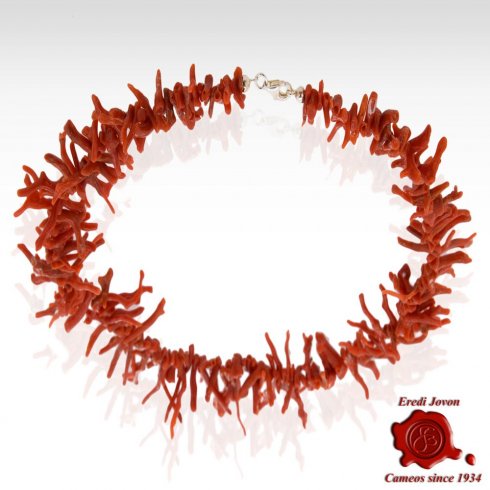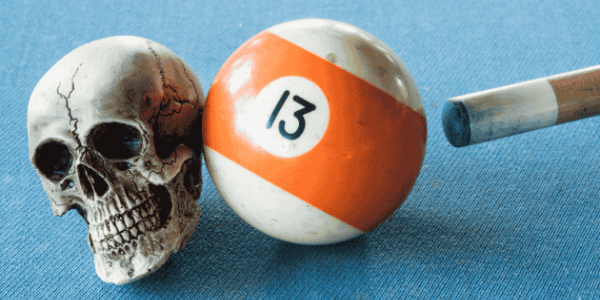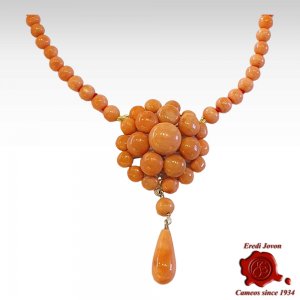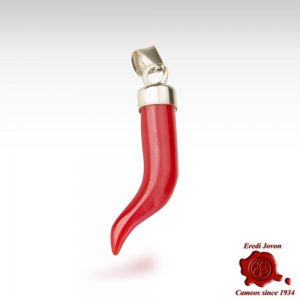Coral, Magic and Medicine: how various cultures have used this precious material

The Magic of Coral and its roots
Starting from the assumption that we have been talking about red coral for at least 4,000 years and there are ample archaeological finds to testify this statement, today I will tell you a little-known topic concerning this precious material and that is, its being present in various cultures as a talisman, as a therapeutic aid or even as a medical remedy.
The western myth
For the ancient Greeks, this gem has mythological roots: Perseus, after killing Medusa, goes to wash his hands in the sea and the drops of the Gorgon's blood (which had the power to petrify men), depositing on marine plants, create coral red. In fact even today some aquatic plants are called "gorgonians". For Greek mythology this precious material represented physical beauty.
The primitive use for coral was certainly that of the amulet: "wear it on your body and it will keep disease, danger and death away!"
Coral Italian culture
The lucky red horn vs the Gold Cornicello
In the Italian imagination, the "rubrum" has extraordinary properties: let’s not forget that in the "Bel Paese" the prototype of the amulet is the red coral horn or, why not, a more modern coral heart.
About the power of the horn amulet the millenary dispute about the strength of the apotropaic materials til ltoday has not an ultimate winner.
Is the coral one the mighty cornicello or is the the Italian horn necklace gold the most potent?
Let's give a final judgment to this diatribe: coral horn is great for health and love, the Italian horn in gold is great for money and wealth.
Since Roman times, a red amulet was given to children to protect them and speed up their teething, and a red ring to women to promote their fertility. In Italy this amulet was called "spuntadentini" (teeth grower) and was believed to have almost thaumaturgical properties.

Red Italian Coral Jewelry
Red Italian Coraljewelry in 18 kt Gold or in White Silver 925% - Certificate Included
Red Coral JewelryCoral in medicine
Over the centuries, coral has been used in the form of porphyrized powder in concoctions and potions.
The great physician Discorides, in the first century after Christ, speaks of the red saplings as a panacea for the cure of every disease. For Pliny it had the power to prevent and stop epistaxis.
I would like to point out a detail: the shape of the coral does not remind you a little of that of the "blood system"?
With this information in mind, do you understand why Jesus, in many paintings, wears a sprig or a coral necklace?
In the Middle Ages, Avicenna, father of the medicine of the time, recommended it to "cheer up the strength of the heart": in short, albeit in a very modest way, he recommended it as an aphrodisiac.
We can say that the coral was the Medieval Viagra!
For the physician-philosopher Paracelsus, if manipulated by an expert, coral was a "medicine to be preferred to all the treasures of the world".
But do not be surprised by labeling these practices as antiquated superstitions: coral is still used in pharmacies in a vast array of products, especially in China, but also in Europe, in the very rational Germany.

Genuine Horn with Red Italian Coral
Genuine Red Italian Coral Horn for your Lucky Charm Bracelet.
Red Coral HornCrystal therapy is the theory according to which a stone can store the energies inside it and give the body, through contact, all its psychological and physical benefits.
Astrologically, red coral is associated with the planet Mars and, being necessarily associated with water (where it is born and thrives), it intercepts the sphere of emotions, thus affecting the facts of love, intuition and femininity in general.
Coral, Indian Vedic astrology and philosophy tradition
For the Indian tradition, coral represents wealth and must be worn and displayed.
The importance of physical contact, or at least the close proximity (you don't need to touch it directly) to the skin is essential to allow the stone to radiate its energy.
This philosophy defines the mantras that serve to charge the coral with positive energies and even the size of the stone, which must be worn in order to better develop its benefits.
Weight is often expressed in carats, which, as we know, can simply be converted into grams. Often even those that are usually considered "defects" of coral are well regarded, because they accentuate the naturalness and magical effect.
What are you bringing home today:
· Coral has traditions that are lost in the mists of time
· It has always been associated with physical and mental health and well-being
· It has a strong connection with blood and heart
· It is associated with fertility and the protection of newborns
· It has a highly positive and apotropaic value
· It seems to contain the 3 different kingdoms of nature: animal, mineral and vegetable
· Some populations even consider it magical
I leave you, as always, with the biggest hug in the world and, if you have the opportunity, share this article on your social networks, the knowledge must be spread and your friends will thank you.

If you liked this Post maybe you'll love:
Information
Last post
-

Love Hope Faith Amulet | Meaning and Tradition
Discover the meaning of the Faith, Hope & Charity charm: a timeless amulet to wear every day. A jewel that tells...
-

The Four-Leaf Clover: the rare gift that dares to speak to the heart
Discover the true meaning of the four-leaf clover and its Italian twist with the lucky cornetto charm—a rare story...
-











